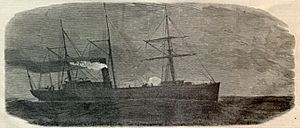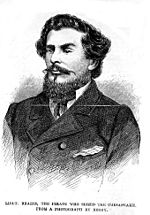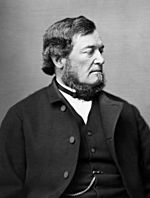Chesapeake Affair facts for kids
The Chesapeake Affair was an important event during the American Civil War. It was a big problem between countries. On December 7, 1863, people who supported the Confederacy from Canada captured an American ship called the Chesapeake. This happened off the coast of Cape Cod in Massachusetts.
The plan was led by Vernon Guyon Locke and John Clibbon Brain. They were from Nova Scotia. During the capture, one American crew member was killed by George Wade from New Brunswick. This was the first time the Confederacy caused a death in the waters near New England.
The captors wanted to get more coal for the ship in Saint John, New Brunswick. Then they planned to sail south to Wilmington, North Carolina. But they had trouble in Saint John. So, they sailed further east to Halifax, Nova Scotia to get coal.
American forces chased the ship. They even tried to arrest the captors in Nova Scotian waters. This was against British rules because Nova Scotia was British land. This made things very tense between the United States and Britain. Wade and others got away with help from William Johnston Almon. He was an important person in Nova Scotia and a Confederate supporter.
The Chesapeake Affair was one of the most exciting international events of the American Civil War. For a short time, it seemed like the British Empire might join the war against the North.
Quick facts for kids Chesapeake Affair |
|||||||
|---|---|---|---|---|---|---|---|
| Part of the American Civil War | |||||||
 The steamer Chesapeake, illustration from Harper's Weekly, December 26, 1863. |
|||||||
|
|||||||
| Belligerents | |||||||
In support of: |
|||||||
| Commanders and leaders | |||||||
|
|||||||
| Units involved | |||||||
| Maritime pirates | Union Navy | ||||||
| Casualties and losses | |||||||
| None | 1 killed 3 wounded |
||||||
Contents
Why the Chesapeake Affair Happened
At the start of the American Civil War, most people in Canada and the Maritime Provinces (like Nova Scotia and New Brunswick) supported the North. This was because the North had ended slavery. Also, many families had relatives living across the border in the United States. About 20,000 men from British North America even went to fight, mostly for the North.
As the war continued, things changed. Britain said it would stay neutral, meaning it wouldn't pick a side. But trade between British ports like Halifax and both the North and South grew a lot. Halifax became a busy port. It supplied coal and fish to the North. It also became a main place for the Confederacy to do business. The Confederacy even had an unofficial office there.
The North tried to stop supplies from reaching the South by setting up a naval blockade. But many ships, called blockade runners, used Halifax to get goods between Britain and the Confederate States. Much of the fuel for Confederate ships came through Halifax.
People in Canada also started to worry about the United States. They saw how powerful the North was becoming. They feared the U.S. might try to take over British North America after the war. Cities like Toronto, Montreal, and Halifax became centers for Confederate spies and soldiers. These groups tried to cause trouble for the North from Canada. For example, there was a raid on St. Albans, Vermont. The plan for the Chesapeake Affair was also made in Canada. Supporters of the Confederacy in Saint John, New Brunswick, planned to capture an American ship. They wanted to use it to help the South.
How the Ship Was Captured
Vernon Guyon Locke arranged for John C. Braine and sixteen other Confederate supporters to get on the Chesapeake. They boarded the ship in New York as regular passengers. The ship was heading to Maine.
On the night of December 7, off the coast of Cape Cod, Braine and his men took over the ship. The crew fought back. During the fight, the ship's second engineer was killed. Three other crew members were hurt. After taking control, Locke took command of the ship near Grand Manan Island.
Rules said that captured ships could not be brought into British waters. So, Locke sailed the Chesapeake to Saint John, New Brunswick, as planned. But he couldn't get coal there. Next, he took the Chesapeake to Nova Scotia. The ship stopped at Shelburne and then at Conquerall Bank, Nova Scotia. They managed to get some coal there. Over the next two days, they sold some of the stolen goods to buy supplies.
Meanwhile, two U.S. Navy warships were getting close. The USS Malvern was coming from Halifax. The USS Dacotah was coming from Shelburne.
The Chesapeake almost got caught by the Malvern on the LaHave River. But under the cover of night, the Chesapeake turned off all its lights. It quietly slipped away without being seen. The Chesapeake avoided capture again at Lunenburg and continued to Halifax. Some crew members left the ship at St. Margarets Bay. By December 16, the ship reached Mud Cove harbour at Sambro. From there, Locke went to Halifax by land. He arranged for a smaller boat to bring coal to Sambro. While the Chesapeake was getting coal, the Malvern and Dacotah arrived.
The Arrests
When the American warships arrived, most of the rebel crew on the Chesapeake ran away. A U.S. officer named Lieutenant Nickels from the Malvern arrested the three men who stayed behind. One was from New Brunswick and two were from Nova Scotia. George Wade, who had killed a crew member during the raid, was one of those arrested.
The Americans took the Chesapeake to Halifax. They wanted permission from the British authorities for what they had done. The Chesapeake arrived in Halifax on December 17. It was escorted by the two American warships. Three other warships that had also chased the Chesapeake followed them. These were the USS Acacia, USS Cornubia, and USS Niagara.
The U.S. Secretary of State, William H. Seward, told Britain that the U.S. wanted the Chesapeake back right away. They also wanted the captors arrested and sent to the U.S. for trial.
The Escape
William Johnston Almon was seen as the unofficial Confederate representative in Halifax. He often helped Confederate "refugees" and hosted important Confederate officials. He was a friend of Confederate President Jefferson Davis. Almon worked with Alexander Keith, Jr. to help the Confederates get free.
The British court was deciding what to do with the Chesapeake. But the British planned to give George Wade, the Confederate prisoner, to the United States. Almon and Keith helped Wade escape in a rowboat. He went to Ketch Harbour and then to Hantsport. The Americans were very angry about this. In response, the British issued an arrest warrant for the rest of the crew. A few of the crew were tried in court but were found not guilty because of a small legal detail.
What Happened After
The Confederate supporters thought they were acting in a war. They had a special letter from the Confederacy that they believed made their actions legal. But as the investigation went on, it was found that their letter was not valid. So, the Chesapeake Affair was not seen as an official act of war. Instead, it was called an act of piracy. Most newspapers in the Maritimes agreed with this.
After the war, many high-ranking Confederates moved to Canada. About 30 senior Navy and Army officers from the South settled in Halifax. Some of the most well-known were John Wilkinson and John Taylor Wood.




